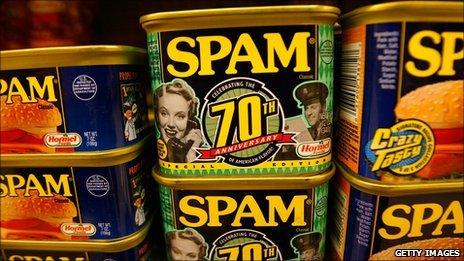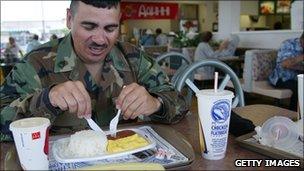How the US cemented its worldwide influence with Spam
- Published

Most people can probably remember the moment when they first realised the seductive power and global pervasiveness of American culture.
I had bought a bootleg CD of The Beach Boys' surfing songs in the remote north-eastern Russian republic of Sakha and had my photograph taken with a goat herder in Djibouti who was wearing a Six Million Dollar Man T-shirt.
It is an extraordinary form of soft power which will endure even if the looming powerhouses of China, India and Brazil come to overshadow America's global economic dominance.

Spam, Spam, Spam - The Spamjam restaurant in Manila serves almost everything with Spam
After all, even when you're watching a Chinese flat-screen TV and driving an Indian car powered with Brazilian biofuels you almost certainly won't be wearing Indian-style clothing or humming Chinese pop songs as you go. Or watching Brazilian movies either.
Next time you see television pictures of an anti-American demonstration anywhere on earth look closely at the crowd. Among the flag-burners you'll almost certainly see someone wearing an LA Lakers shirt or a Yankees baseball cap.
My first exposure to American culture came back in the Doris Days of the early 1960s, growing up in a Britain that was still shaking off the lingering effects of rationing and the costs of post-war reconstruction.
We had Elvis, of course, and Hollywood but the world was a lot less global then. It was still possible, for example, for British recording artists to have hit records by simply recording their own versions of songs that were already hits for American stars on the far side of the Atlantic.
Spam Central
But the flagship of American influence in my own life was Spam, the bright-pink pork luncheon meat that was a staple of the British working-class diet for several decades.
It's still going strong in many markets around the world - including the United States - and although the odd concession has been made to changing times (it's less fatty and salty than it used to be) it's still essentially the same as it always was.
I came to know it in the early 1960s, in the days before the invention of obesity. In common with millions of other British families we used to slice it, coat it in batter and then deep-fry it, thus producing that miracle of British culinary ingenuity known as the spam fritter.
So when the time came to find a way to round off my three years as the BBC's North America correspondent, it seemed somehow fitting to head not for the bright lights of New York or Chicago but for the less showy charms of Austin, Minnesota, home of the Hormel Food Company. Spam Central, in short.

Fighting fit - Spam and egg for breakfast
It would be fair to say that Austin, like a lot of cities in the northern Mid West, is not flattered by the grim, flat light of early winter. But the Spam Museum, which is its main tourist attraction, is a riot of cheery colour.
Inside you are treated to the services of a "Spambassador" (I said it was colourful, not subtle) and you enjoy a movie presentation that draws heavily on the musical work of a group of ladies called the Spamettes.
And it turns out that it's not fanciful at all to see Spam as a symbol of the spread of American influence.
Our Spambassador Chris George tells us that the product was already popular in the United States in the 1930s - the first radio jingle, in fact, is a kind of ode to Spam set to the tune of My Bonny Lies Over the Ocean.
Versatile and delicious
"It was World War II that made Spam international because American GIs brought it all over the world," he says. "And when there was food rationing in Britain and continental Europe, Spam was versatile, delicious, easy to transport and it kept a long time. Those are important qualities."
Even allowing for the Spambassador's genius for turning every sentence about the stuff into a commercial, you can see the truth of that.
The museum is honest enough to acknowledge that the GIs themselves got a little sick of Spam which they ate almost every day. But you can almost map the progress of their campaigns through the trail of portable, porky protein they left behind.
Spam went to Europe of course but it went East as well and left its mark in Hawaii (home of the US Pacific Fleet at Pearl Harbor), Japan, Guam and eventually Korea.
It conjures up a strange new perspective on World War II - GIs struggling to get over the beaches of Normandy and across the sands of Iwo Jima before their arteries clogged up. But it makes you wonder if this is the reason why they put Spam in brick-shaped tins, because America used it to build its influence in a hungry post-war world.
Cheeky brand
Indeed it was the very ubiquity of Spam that made it seem so risible to Monty Python. But if they thought they had killed the brand with ridicule, they were sadly mistaken. Their celebrated sketch has pride of place in the museum. Evidence, muses Spambassador Chris philosophically, of the cheekiness of the brand.
You are perhaps unlikely to stumble across the home of Spam unless you find yourself driving from Minneapolis to Des Moines but it's genuinely worth a visit as a case study in how an iconic brand helped to introduce a wider world to American brands and ideas.
It's quite a while since we stopped marvelling at the convenience of convenience food and started worrying about it was doing to us, but Spam continues to keep its place in a changing world.
It is not much use as a nation-building tool in America's modern wars in Iraq and Afghanistan for example (pork, remember) but these are tough times in America and domestic sales are going rather well.